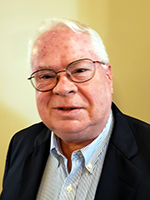Mitochondrial Pathologies and Therapeutic Development – A Tribute to Craig C. Beeson
Tuesday April 27, 2021
12:00 pm
-
1:30 pm
Central Time (CT)
View session on the EB Virtual Platform (EB registration required)
DDD
MP
Chair :
 Rick Schnellmann
Rick Schnellmann
University of Arizona
 John Lemasters
John Lemasters
Medical University of South Carolina
Increasingly, mitochondrial dysfunction is recognized to play an important role in the pathophysiology of many prevalent diseases. Thus, mitochondria represent an important drug target for diverse diseases. Using examples from liver, kidney and the nervous system, this symposium will highlight new developments in experimental therapeutics designed to reverse mitochondrial pathologies and enhance recovery of mitochondrial function. Development of a mitochondrial pharmacology holds promise to fill therapeutic voids in disease management. This symposium will be presented in honor of the late Prof. Craig C. Beeson and will include brief tributes.
Speakers
John Lemasters
- Medical University of South Carolina
Mitochondria in the Pathogenesis of Alcoholic and Non-alcoholic Steatohepatitis
Aldehydes form during ethanol metabolism and during lipid peroxidation. To promote NAD+ formation for aldehyde detoxification by mitochondrial aldehyde dehydrogenase-2, mitochondria depolarize to stimulate respiration, and voltage dependent anion channels (VDAC) close to prevent futile ATP hydrolysis. We propose that persistence of depolarization and VDAC closure is a pathogenic tipping point that links adaptive mitochondrial aldehyde metabolism to maladaptive changes initiating onset and progression of alcoholic and non-alcoholic steatohepatitis (ASH and NASH).
Bärbel Rohrer
- Medical University of South Carolina
Targeting Mitochondrial Homeostasis for Neuroprotection
Neurodegenerative eye diseases represent a significant and growing untreated population, with over 10 million patients globally without a treatment, and mitochondrial dysfunction is implicated in the underlying pathological basis for tissue damage. Craig Beeson and I have developed a library of small molecules with a unique mechanism of action that protect mitochondrial function, regardless of the underlying cause of stress or dysfunction.
Rick Schnellmann
- University of Arizona
Mitochondrial Biogenesis as a Therapeutic Target
Mitochondrial dysfunction plays a role in the initiation of disease and/or progression of disease. We propose that the stimulation of mitochondrial biogenesis and recovery of mitochondrial function restores/prevents disease.
Eileen Kennedy
- University of Georgia, College of Pharmacy
Therapeutic Development of LRRK2 Inhibitors using Constrained Peptides
LRRK2 plays an important role in Parkinson’s disease pathogenesis including mitochondrial impairment. We have developed allosteric inhibitors that disrupt LRRK2 activation and may serve as a new strategy for the treatment of Parkinson’s.
Whitney Gibbs
- Boston Children's Hospital
The Protective Role of the 5-HT1F Receptor in Acute Kidney Injury: A Novel Target for Mitochondrial Biogensis
Our lab identified the 5-HT1F receptor as a regulator of basal mitochondrial biogenesis in vitro and in vivo. This work revealed the unique mechanism by which the 5-HT1F receptor mediates renal mitochondrial biogenesis and demonstrates the critical need for the 5-HT1F receptor in renal recovery.
Pallavi Bhargava
- DILIsym Services
QST/QSP Modeling of Mitochondrial Dysfunction in Drug-Induced AKI
Mitochondrial dysfunction plays an important role in the development of drug-induced acute kidney injury. RENAsym is a mechanistic mathematical model that combines compound exposure and relevant in vitro data, such as compound effects on mitochondrial function, to aid in the prediction of drug candidates that can cause renal injury.